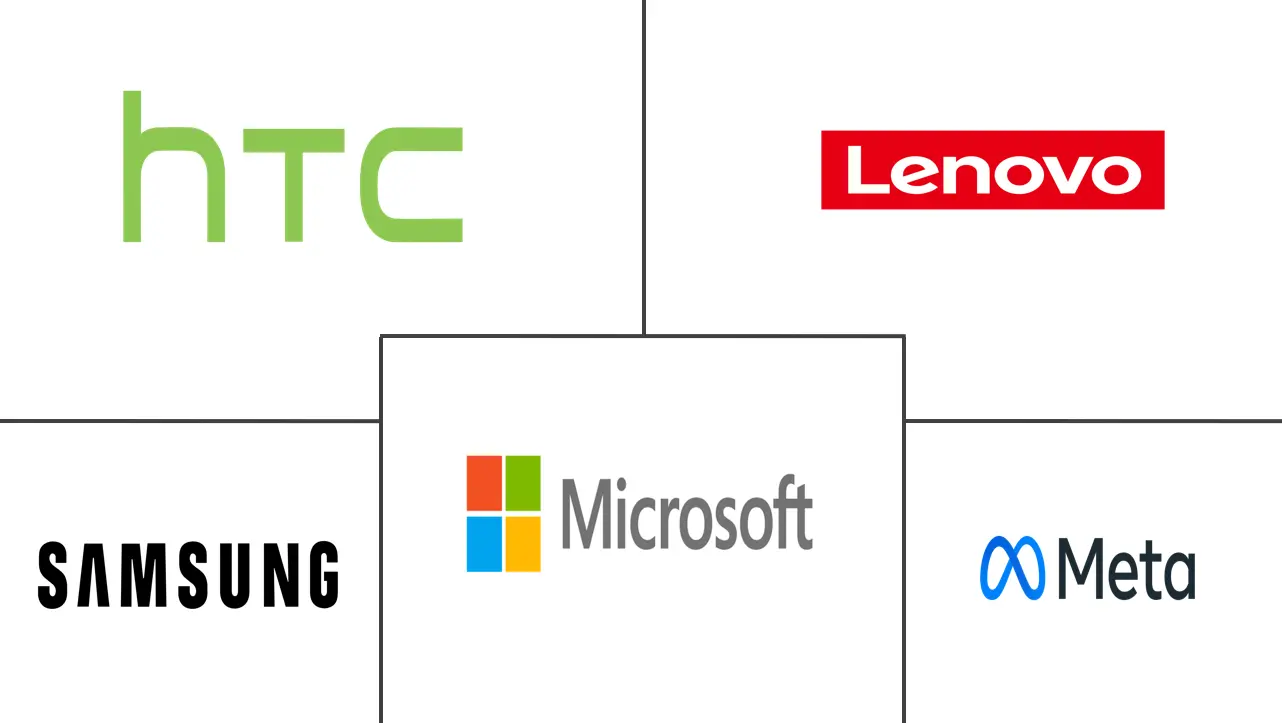Virtual Reality In Education Market Size and Share
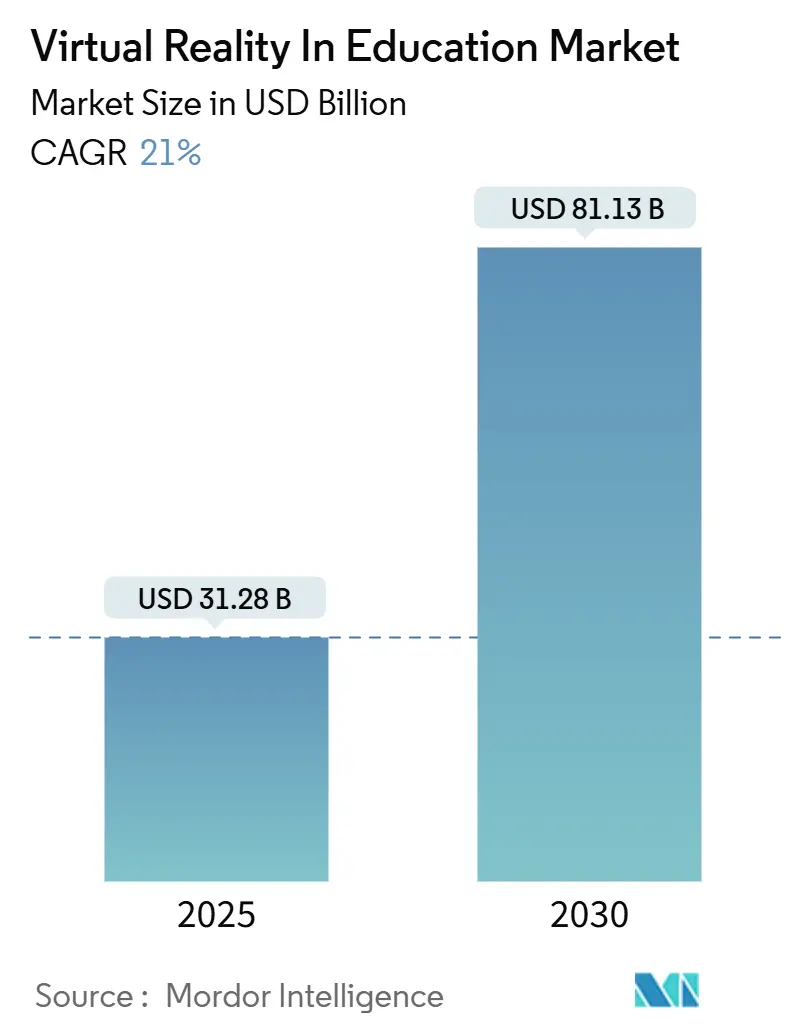
Virtual Reality In Education Market Analysis by Mordor Intelligence
The Virtual Reality In Education Market size is estimated at USD 31.28 billion in 2025, and is expected to reach USD 81.13 billion by 2030, at a CAGR of 21% during the forecast period (2025-2030).
Lower headset prices, sizable government grants, and measurable improvements in learner performance continue to propel the virtual reality in education market, especially as corporations adopt immersive training programs that reduce seat time by up to 75% while quadrupling knowledge retention. Hardware still supplies most revenue, but service-oriented subscription packages are expanding fastest as institutions seek turnkey content and analytics. North America leads the adoption due to the Biden–Harris Administration’s USD 277 million innovation fund, whereas the Asia Pacific accelerates on the back of Chinese and Japanese infrastructure programs. Competitive rivalry is moderate, as large platforms such as Meta and Microsoft contend with specialists like zSpace and Labster, which pair curriculum-aligned content with cost-effective deployment models.
Key Report Takeaways
- By component, hardware led with 61.5% of the virtual reality in education market share in 2024 while services are forecast to expand at 22.78% CAGR through 2030.
- By end user, academic institutions held 65.45% of the virtual reality in education market size in 2024; corporate training is advancing at 23.57% CAGR to 2030.
- By device type, standalone headsets dominated the virtual reality in education with 70.34% share in 2024, while mixed-reality HMDs are projected to grow at 23.94% CAGR through 2030.
- By application area, academic institutions held 36.78% of the virtual reality in education market size in 2024; Soft-skills is advancing at 21.89% CAGR to 2030.
- By geography, North America accounted for 39.34% of the virtual reality in education market size in 2024; Asia Pacific is anticipated to record the highest regional CAGR at 22.01% to 2030.
Global Virtual Reality In Education Market Trends and Insights
Drivers Impact Analysis
| Driver | (~) % Impact on CAGR Forecast | Geographic Relevance | Impact Timeline |
|---|---|---|---|
| Rising demand for interactive and personalized learning | +3.2% | Global, with early adoption in North America and EU | Medium term (2-4 years) |
| Greater stakeholder acceptance from higher engagement | +2.8% | Global, strongest in APAC and North America | Short term (≤ 2 years) |
| Falling prices and ubiquity of standalone VR headsets | +4.1% | Global, with cost sensitivity highest in APAC and Latin America | Short term (≤ 2 years) |
| Government/Institutional EdTech funding post-COVID | +3.5% | North America, EU, and China leading initiatives | Medium term (2-4 years) |
| Integration of eye-tracking analytics for adaptive VR | +2.3% | North America and EU early adopters, APAC following | Long term (≥ 4 years) |
| WebXR standards lowering total cost of ownership | +1.9% | Global, with developer concentration in North America and EU | Long term (≥ 4 years) |
| Source: Mordor Intelligence | |||
Rising Demand for Interactive and Personalized Learning
Institutions increasingly value immersive lessons that adapt to diverse learning styles, with studies showing VR learners achieve 275% higher confidence and complete courses four times faster than classroom cohorts. Universities highlight gaps in design-thinking skills within current VR curricula, opening opportunities for providers that combine technical rigor with pedagogy.[1]University of British Columbia, “Interaction Design for VR Applications: Understanding Needs for University Curricula,” UBC.CA AI-driven engines tailor content to each learner; zSpace’s Career Coach AI, for instance, matches local labor-market data to personalized study pathways[2]zSpace, “zSpace Introduces zSpace AI,” ZSPACE.COM Controlled virtual environments also reduce anxiety for students with emotional impairments while boosting retention. As learner-centric models move mainstream, the virtual reality in education market becomes core infrastructure for institutions seeking improved outcomes.
Greater Stakeholder Acceptance from Higher Engagement
Quantified gains are persuading administrators, parents, and corporate L&D heads alike. Nursing programs see 95% participation when scenarios run in VR versus 15% in traditional labs. Manufacturing firms report 43% drops in workplace injuries after VR safety drills. Classroom engagement spikes in mathematics when students manipulate 3-D objects that clarify abstract concepts. Meta’s program with 13 universities demonstrates institutional confidence, creating reference sites that spur peer adoption. These outcomes generate a virtuous cycle of investment and acceptance for the virtual reality in education market.
Falling Prices and Ubiquity of Standalone VR Headsets
Entry devices such as Quest 2 remain under USD 299, aligning with the sub-USD 400 threshold most districts require for bulk purchase. Standalone form factors erase the need for high-end PCs, slashing total cost of ownership and simplifying IT support. Large-scale deployments, East Renfrewshire Council equipped every Scottish school with ClassVR units, illustrate affordability-driven expansion. Google’s USD 250 million stake in HTC VIVE should intensify price competition and accelerate hardware improvements. As price points continue to fall, the addressable base for the virtual reality market in education broadens across emerging economies.
Government/Institutional EdTech Funding Post-Pandemic
Post-pandemic recovery plans include sizable VR earmarks. The European Commission has allocated EUR 1.3 billion for digital skills programs between 2025-2027, explicitly citing virtual worlds in education. The U.S. National Science Foundation’s RITEL scheme sets aside USD 25 million for immersive-learning research.[3]U.S. National Science Foundation, “Research on Innovative Technologies for Enhanced Learning (RITEL),” NSF.GOV China’s provinces collectively issued VR tenders exceeding USD 15 million in 2025 targeting vocational campuses. Japan’s DX High School program offers grants of JPY 10 million per campus to upgrade digital curricula Such policies embed VR within national education strategies, offering long-term stability to the virtual reality in education market.
Restraints Impact Analysis
| Restraint | (~) % Impact on CAGR Forecast | Geographic Relevance | Impact Timeline |
|---|---|---|---|
| Scarcity of quality curriculum-aligned VR content | -2.7% | Global, most acute in non-English speaking regions | Medium term (2-4 years) |
| High upfront and maintenance costs for institutions | -3.4% | Developing economies and budget-constrained districts | Short term (≤ 2 years) |
| Biometric data-privacy concerns in classrooms | -1.8% | EU under GDPR, US under FERPA/COPPA frameworks | Long term (≥ 4 years) |
| Teacher training gaps and pedagogical resistance | -2.9% | Global, with rural and under-resourced areas most affected | Medium term (2-4 years) |
| Source: Mordor Intelligence | |||
Scarcity of Quality Curriculum-Aligned VR Content
Many applications prioritize entertainment over pedagogy, leaving educators short of materials that match learning standards, especially outside English-speaking markets. Teachers struggle to locate VR modules that embed assessment tools and constructivist methods, hampering adoption despite hardware availability. Specialized domains such as medicine need regulatory compliance, yet the pipeline of validated scenarios remains thin. Partnerships like Pearson–XR Bootcamp illustrate early progress but are insufficient to satisfy global demand. Until content libraries scale, growth of the virtual reality in education market will trail underlying hardware capability.
Teacher Training Gaps and Pedagogical Resistance
Surveys reveal that most current VR professional-development programs concentrate on natural sciences and younger faculty, sidelining other subjects and veteran teachers. Educators cite concerns over dizziness, classroom management, and unclear instructional value. Programs like Unity’s 30-hour “Create with VR for Educators” course address skills shortages but scale remains limited relative to global need. Peer-support networks such as “Educators in VR” help diffuse best practices yet cannot replace formal training. Bridging these gaps is essential for sustained expansion of the virtual reality in education market.
Segment Analysis
By Component: Hardware Dominance Shifts to Service Models
Hardware captured 61.5% of the virtual reality in education market share in 2024 on the strength of device rollouts across schools and training centers. However, the services segment is on pace for 22.78% CAGR as institutions favor subscription bundles that bundle content, device management, and analytics. The virtual reality in education market size tied to services is poised to overtake software revenue approaching 2030. Standalone headset affordability keeps hardware relevant, yet platform vendors are already bundling perpetual updates, reducing replacement cycles.
Subscription models also mitigate capital-expenditure barriers for districts with limited budgets. ArborXR’s shift into learning analytics and zSpace’s AI-powered guidance tools illustrate how vendors convert hardware footholds into recurring-revenue ecosystems. Training and consulting services that improve instructional design now factor prominently in RFPs. These patterns signal a pivot toward outcomes-based procurement, reinforcing recurrent income streams across the virtual reality industry.
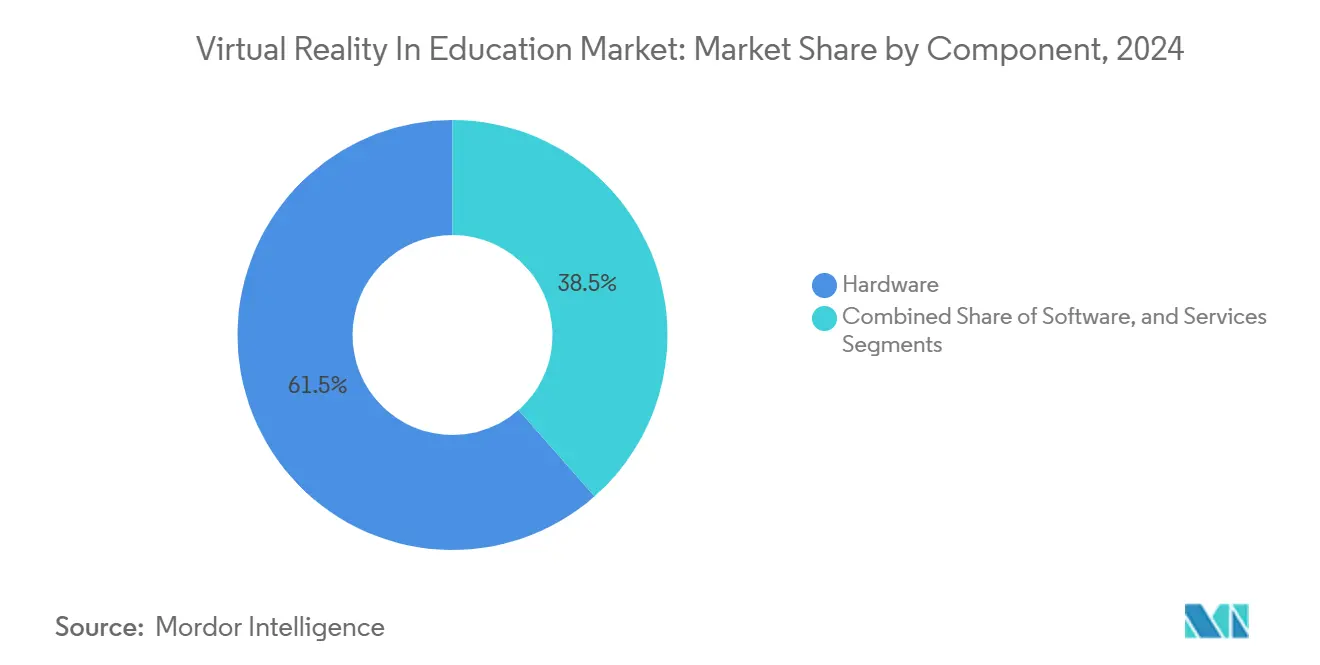
Note: Segment shares of all individual segments available upon report purchase
By End User: Corporate Training Outpaces Academic Adoption
Academic institutions still own 65.45% of the virtual reality in education, reflecting early grant-funded pilots across K-12 and universities. Yet corporate training advances at 23.57% CAGR, propelled by measurable ROI in safety, compliance, and customer-service scenarios. The virtual reality in education market size attributable to enterprises is projected to approach parity with academia by 2030. Corporations in healthcare and mining have logged 40%-plus error reductions after immersive programs, shortening payback periods.
Enterprises champion soft-skills and product-knowledge modules, fueling demand for rapid-authoring tools and analytics integrations. Academic growth continues but faces budget cycles and curriculum-approval processes. For vendors, diversified portfolios that address both segments offer resilience against economic swings within the virtual reality industry.
By Device Type: Standalone Dominance with Mixed-Reality Acceleration
Standalone units led with 70.34% share as their cable-free form factor aligns with classroom realities. Mixed-reality headsets are forecast to post 23.94% CAGR, spurred by Apple Vision Pro and upgraded HoloLens editions that merge physical and digital contexts. The virtual reality in education market size related to standalone units will keep expanding, but their share will gradually cede to mixed-reality devices as costs converge.
Teachers value simplicity; thus device-management platforms like ArborXR that deliver remote updates and content locking are gaining traction. High-end tethered rigs remain in specialized labs for surgical and engineering simulations. Over time, falling silicon prices and cloud rendering should blur device categories, accelerating feature convergence across the virtual reality industry.
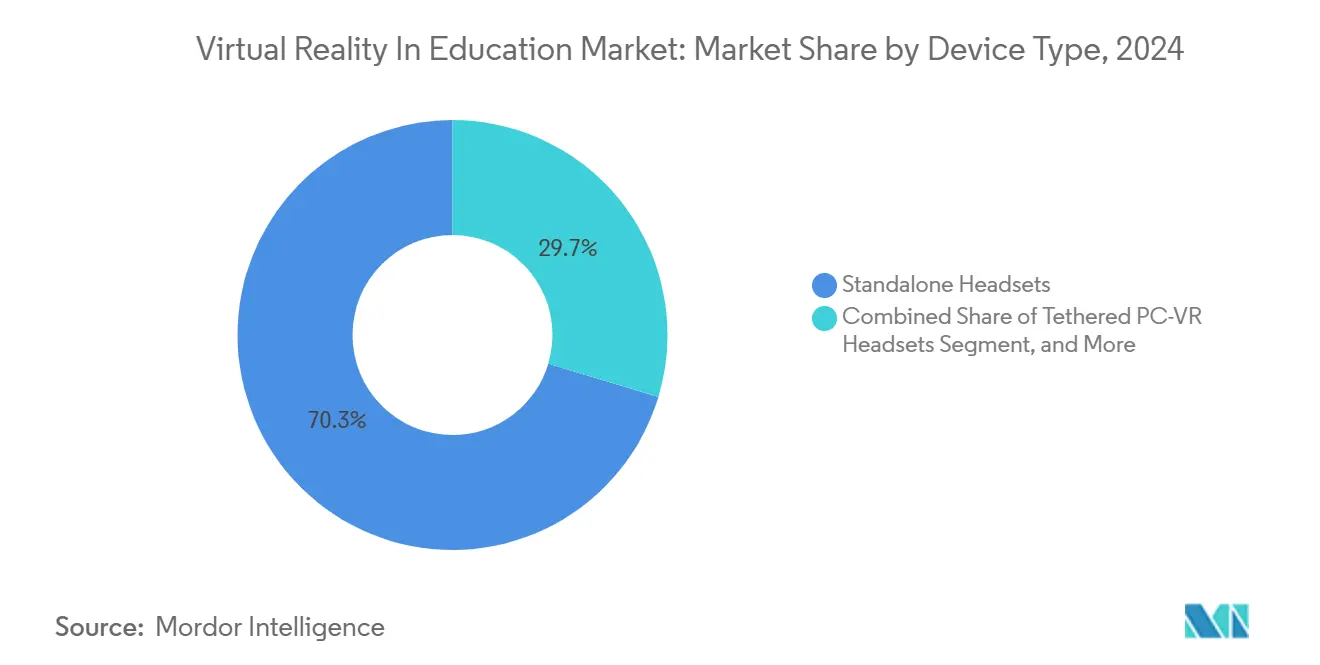
Note: Segment shares of all individual segments available upon report purchase
By Application Area: STEM Foundation with Soft-Skills Acceleration
STEM disciplines comprised 36.78% of application revenue in 2024 as 3-D visualization naturally improves comprehension of molecular structures and mechanical systems. Soft-skills scenarios now log the fastest expansion at 21.89% CAGR, mirroring corporate focus on leadership and communication competencies. The virtual reality in education market size attached to STEM tracks steady grant funding, whereas soft-skills growth depends on enterprise subscription renewals.
Medical-training platforms deliver validated results, such as 26% knowledge gains after a single surgical module. Language learning in VR receives venture capital, evidenced by Immerse’s USD 9 million round to build spatial language labs. As pedagogical research broadens, cross-disciplinary curricula will fuel balanced growth for the virtual reality industry.
Geography Analysis
North America retained 39.34% of 2024 revenue thanks to robust grant programs and a mature EdTech ecosystem. The Administration’s USD 277 million innovation grants earmark immersive algebra tools, while the National Science Foundation commits USD 25 million to R&D, seeding university partnerships. Corporate uptake spans healthcare, retail, and skilled trades as companies such as Interplay Learning scale VR modules for talent shortages. These forces keep the virtual reality market in education expanding at a healthy clip, though growth moderates as penetration rises.
Asia Pacific is set to log the fastest regional CAGR of 22.01% through 2030. China’s provinces issued tenders exceeding USD 15 million for vocational VR labs in 2025 alone, while Japan’s DX High School scheme funds up to JPY 10 million per campus for digital upgrades. South Korean institutions deploy VR to cut equipment costs in technical training, an approach highlighted by World Bank researchers.[4]World Bank Blogs, “How Korea Is Preparing for the Jobs of the Future,” WORLDBANK.ORG These coordinated policies accelerate classroom integration, positioning Asia Pacific to narrow its gap with North America in the virtual reality in education market.
Europe benefits from the Digital Europe Programme’s EUR 1.3 billion allocation and EUR 108 million for specialist academies that include virtual-worlds curricula. Scotland’s council-wide ClassVR rollout shows regional bodies embracing systemic procurement. Emerging markets in South America and the Middle East follow as hardware prices dip below USD 300, though infrastructure constraints still curb immediate uptake. Overall, policy alignment and funding density remain the primary predictors of regional traction for the virtual reality in education market.
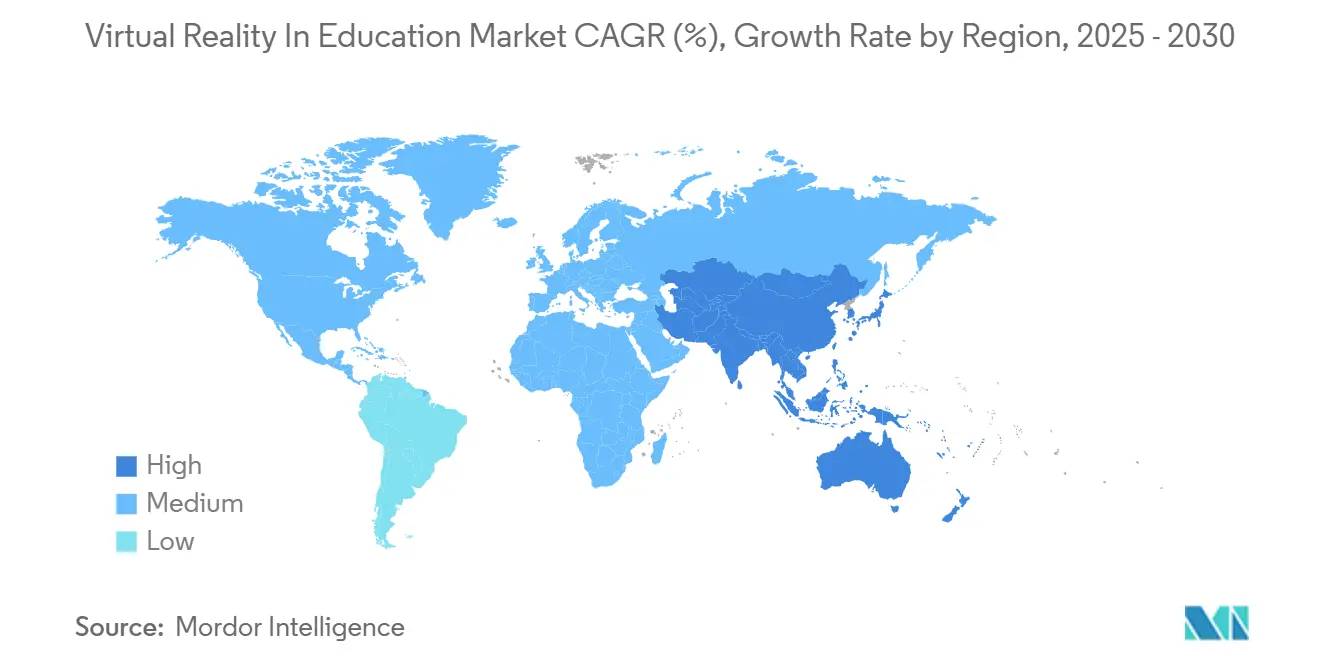
Competitive Landscape
Market structure is moderately concentrated, with global tech platforms leveraging hardware ecosystems while niche specialists focus on curricular depth. Meta couples its Quest lineup with an education portal offering science and history modules, anchoring a broad device-plus-content stack. Microsoft positions HoloLens for high-value mixed-reality training in medicine and manufacturing, often co-selling through Azure. zSpace differentiates through AI-guided career tools, serving more than 3,700 institutions.
Labster leads in virtual labs and bolstered its nursing catalog by acquiring UbiSim to address clinical-training demand. ArborXR widened its moat by absorbing InformXR, adding analytics to its device-management suite. Apple’s Vision Pro entry drives mixed-reality competition; early pilots at Boston Children’s Hospital showcase premium use cases that justify higher pricing. Content localization remains a white space, especially for non-English curricula, prompting alliances between publishers and XR studios.
Data-privacy compliance is gaining strategic weight as schools navigate GDPR and FERPA rules on biometric capture, giving rise to consent-management startups like Secure Privacy. Vendors that can integrate privacy safeguards and deliver teacher-friendly analytics are best positioned to win repeat contracts. Overall, the competitive contest hinges on end-to-end solutions combining hardware affordability, standards-aligned content, and scalable professional development, all instrumental to the sustained growth of the virtual reality in education market.
Virtual Reality In Education Industry Leaders
-
Microsoft Corporation
-
HTC Corporation
-
Lenovo Group Limited
-
Meta Platforms, Inc.
-
Samsung Electronics Co., Ltd.
- *Disclaimer: Major Players sorted in no particular order
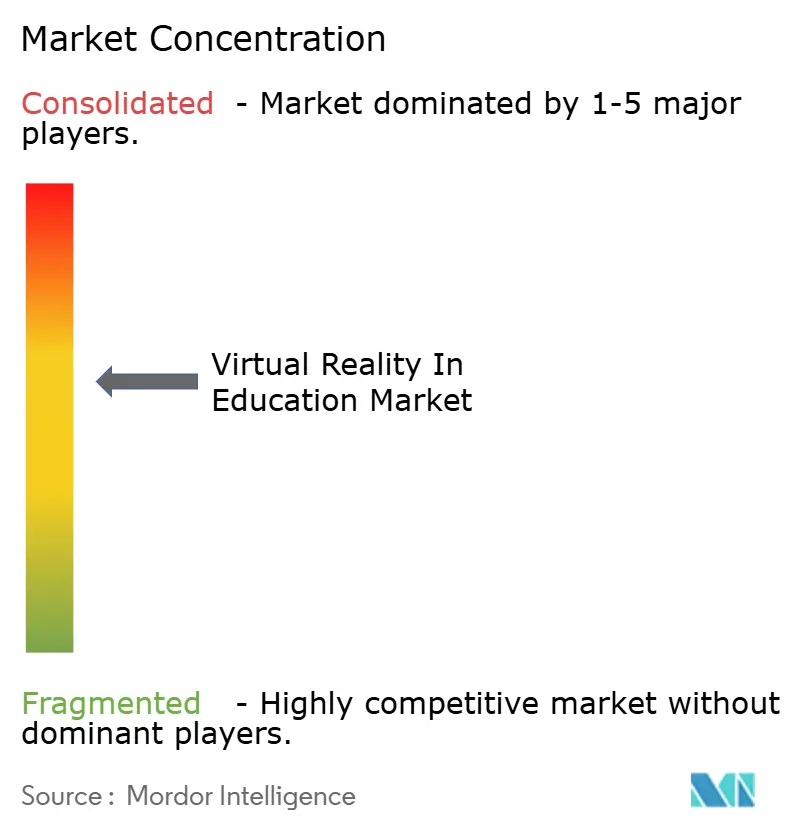
Recent Industry Developments
- August 2025: Google invests USD 250 million in HTC VIVE to advance Android XR headsets and widen access for educators.
- June 2025: zSpace debuts zSpace AI with Career Coach features, now deployed across 3,700 schools.
- May 2025: ArborXR acquires InformXR and launches ArborXR Insights for learner analytics.
- March 2025: European Commission earmarks EUR 1.3 billion for digital-skills programs, including virtual worlds academies.
Global Virtual Reality In Education Market Report Scope
Virtual reality involves the creation of simulated environments that imitate real objects or persons to create an illusion. The creation of such an illusion helps people understand the actual environments of an industry, arena, space, or situation. Virtual reality has applications across various industries, including education, entertainment, defense, and healthcare, which are projected to generate significant revenues in the global market.
The Virtual Reality (VR) in Education Market is Segmented by Component (Hardware, Software, and Services), End User (Academic Institutions, and Corporate Training), Device Type (Standalone Headsets, Tethered PC-VR Headsets, Smartphone-Enabled VR, and Mixed-Reality Head-Mounted Displays), Application Area (STEM and Technical Education, Medical and Healthcare Training, Language and Arts Learning, Vocational and Technical Skills, and Soft-Skills and Team Collaboration), and Geography (North America, Europe, South America, Asia-Pacific, and Middle East and Africa). The Market Forecasts are Provided in Terms of Value (USD).
| Hardware |
| Software |
| Services |
| Academic Institutions | K-12 Learning |
| Higher Education | |
| Corporate Training | IT and Telecom |
| Healthcare | |
| Retail and E-commerce | |
| Other Corporate Users |
| Standalone Headsets |
| Tethered PC-VR Headsets |
| Smartphone-Enabled VR |
| Mixed-Reality Head-Mounted Displays |
| STEM and Technical Education |
| Medical and Healthcare Training |
| Language and Arts Learning |
| Vocational and Technical Skills |
| Soft-Skills and Team Collaboration |
| North America | United States | |
| Canada | ||
| Mexico | ||
| South America | Brazil | |
| Argentina | ||
| Rest of South America | ||
| Europe | Germany | |
| United Kingdom | ||
| France | ||
| Spain | ||
| Rest of Europe | ||
| Asia-Pacific | China | |
| India | ||
| Japan | ||
| South Korea | ||
| ASEAN | ||
| Rest of Asia-Pacific | ||
| Middle East and Africa | Middle East | Saudi Arabia |
| United Arab Emirates | ||
| Turkey | ||
| Rest of Middle East | ||
| Africa | South Africa | |
| Nigeria | ||
| Kenya | ||
| Rest of Africa | ||
| By Component | Hardware | ||
| Software | |||
| Services | |||
| By End User | Academic Institutions | K-12 Learning | |
| Higher Education | |||
| Corporate Training | IT and Telecom | ||
| Healthcare | |||
| Retail and E-commerce | |||
| Other Corporate Users | |||
| By Device Type | Standalone Headsets | ||
| Tethered PC-VR Headsets | |||
| Smartphone-Enabled VR | |||
| Mixed-Reality Head-Mounted Displays | |||
| By Application Area | STEM and Technical Education | ||
| Medical and Healthcare Training | |||
| Language and Arts Learning | |||
| Vocational and Technical Skills | |||
| Soft-Skills and Team Collaboration | |||
| By Geography | North America | United States | |
| Canada | |||
| Mexico | |||
| South America | Brazil | ||
| Argentina | |||
| Rest of South America | |||
| Europe | Germany | ||
| United Kingdom | |||
| France | |||
| Spain | |||
| Rest of Europe | |||
| Asia-Pacific | China | ||
| India | |||
| Japan | |||
| South Korea | |||
| ASEAN | |||
| Rest of Asia-Pacific | |||
| Middle East and Africa | Middle East | Saudi Arabia | |
| United Arab Emirates | |||
| Turkey | |||
| Rest of Middle East | |||
| Africa | South Africa | ||
| Nigeria | |||
| Kenya | |||
| Rest of Africa | |||
Key Questions Answered in the Report
How large is the virtual reality market in education today?
The virtual reality market in education recorded USD 31.28 billion in revenue during 2025 and is projected to hit USD 81.13 billion by 2030.
Which region leads adoption of VR in classrooms and training centers?
North America currently holds 39.34% of spending thanks to sizable U.S. federal grants and a mature EdTech ecosystem.
What is driving rapid growth in Asia Pacific?
Coordinated government funding in China, Japan, and South Korea for VR labs and curriculum upgrades is propelling Asia Pacific toward a 22.01% CAGR.
Which device category dominates deployments?
Standalone headsets account for 70.34% of shipments because they are cable-free, affordable, and easy for school IT teams to manage.
Why are services the fastest-growing component?
Institutions prefer subscription bundles that bundle content, analytics, and support, pushing services toward a 22.78% CAGR through 2030.
Page last updated on:
